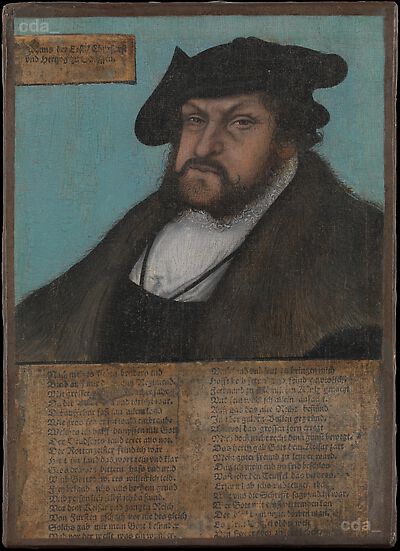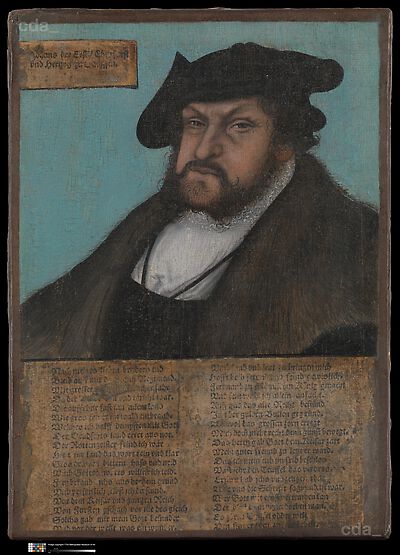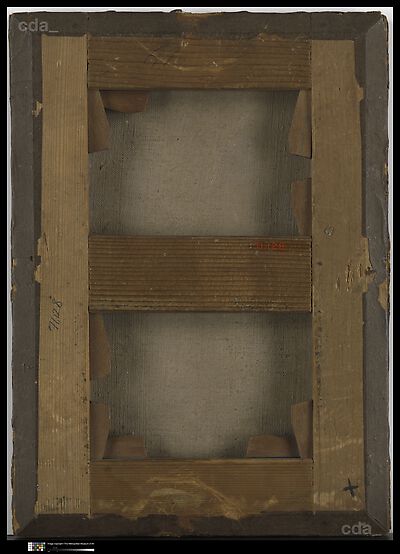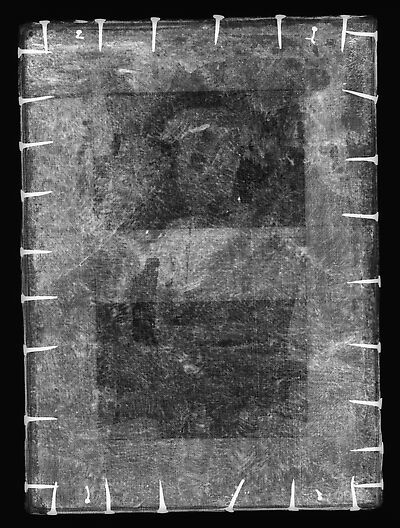- Attribution
- Workshop Lucas Cranach the Elder
Attribution
| Workshop Lucas Cranach the Elder | [Cat. New York 2013, 78, no. 17C] |
- Production date
- 1532 - 1533
Production date
| 1532 - 1533 | [Cat. New York 2013, 78, No. 17C] |
- Dimensions
- Dimensions of support: 21 × 14.9 cm (8 1/4 × 5 7/8 in.)
Dimensions
Dimensions of support: 21 × 14.9 cm (8 1/4 × 5 7/8 in.)
[Cat. New York 2013, 78, no. 17C]
- Signature / Dating
None
- Inscriptions and Labels
Printed texts on paper labels:[1]
-
at top left: '[ J]ohans der Erst, Churfurst / vnd Hertzog zu
Inscriptions and Labels
Inscriptions, Badges:
Printed texts on paper labels:[1]
- at top left:
'[ J]ohans der Erst, Churfurst / vnd Hertzog zu [S]a[c]hssen ( Johann the First, Elector / and Duke of Saxony.)'
- at bottom:
'Nach me[in]es lieben bruders end / Bleib auff mir d[as g]antz Regimend. / Mit grosser [sorg und man]cher fahr / Da der [Bawr to]ll vnd t_richt war. / Die auffrhur fast jnn allem land / Wie gros fewer jm wald entbrand. / Welches ich halff dempffen mit Got[t] / Der Deudsches land erret aus not. / Der Rottengeister feind ich war / Hielt jm land das wort rein vnd klar / Gros drawen bittern hass vnd neid / Vmb Gottes w[o]rts willen ich leid. / Frey bekand jchs aus hertzem grund / Vnd personlich selbst jch da stund. / Vor dem Keisar vnd gantzen Reich / Von Fursten gschach vor nie des gleich / Solchs gab mir mein Go[t]t besnnder [sic; besunder] / Vnd vor der wellt was ein wunder. // V[mb l]and vnd leut [z]u bringen mich / Hofft beid fre[und vnd] feind gewislich. / Ferdnand zu R_mischm K_nig gmacht / Vnd sein wahl jch allein anfacht. / Auff [d]as das alte Recht bestuend / Jnn der gulden Bullen gegruend. / W[ie]wol das grossen zorn erregt / Mich doch mehr recht denn gunst bewegt. / Das herttz gab Gott dem Keisar zart / Mein guter freund zu letzt er ward. / Das jch mein end jm frid beschlos / Vast sehr den Teuffel das verdros. / Erfarn hab jchs vnd zeugen tha[r] / W[i]e vns die Schrifft sagt vnd ist war. / Wer Gott mit ernst vertrawen kan / Der bleibt [e]in vnnerdorben [sic; vnuerdorben, i.e., unverdorben] man. / Es z_r[n]e T [eu] ffel odder welt / D[e]n sieg er doch zu letzt behelt.'
[1] Missing letters in damaged areas are supplied in brackets, based on comparison with intact inscriptions on other elector portraits and on published transcriptions.
[Cat. New York 2013, 78, 290, no. 17C]
Stamps, Seals, Labels:
Reverse of the painting: - on stretcher bar at top:
in graphite, '61'
[Cat. New York 2013, 79, no. 17C]
- Owner
- The Metropolitan Museum of Art, New York
- Repository
- The Metropolitan Museum of Art, New York
- Location
- New York
- CDA ID
- US_MMANY_71-128
- FR (1978) Nr.
- FR-none
- Persistent Link
- https://lucascranach.org/en/US_MMANY_71-128/
-
Provenance
- ? by descent to Martin Comte Cornet de Ways Ruart, Brussels (until d. 1870)
- [Étienne Le Roy, Brussels, 1870; sold through Léon Gauchez, Paris, to Blodgett]; William T. Blodgett, Paris and New York (1870 - 71)
- sold half share to Johnston
- William T. Blodgett, New York, and John Taylor Johnston,
New York (1871) - sold to MMA) [1]
[1] Provenance established in Baetjer 2004, appendix 1A, p. 206, no. 89, and passim.
[Cat. New York 2013, 79, 290, no. 17C]
Literature
| Reference on page | Catalogue Number | Figure / Plate | |||||||||||||
| Cat. New York 2013 | 78-84 | No. 17C | |||||||||||||
|
|||||||||||||||
| Baetjer 2004 | 172, 182, Appendix 1A: 197, 206, Appendix 3: 244, Fig. p. 206 | No. 89 | |||||||||||||
|
|||||||||||||||
| Cat. New York 1995 | 222 | Fig. | |||||||||||||
|
|||||||||||||||
| Exhib. Cat. Kronach 1994 | 335 | under 180b | |||||||||||||
|
|||||||||||||||
| Christensen 1992 | 40, Fn. 10 | ||||||||||||||
|
|||||||||||||||
| Urbach 1991 | 78 | ||||||||||||||
|
|||||||||||||||
| Cat. New York 1980 | 37 (Vol. 1) | Fig. p. 298 (Vol. 2) | |||||||||||||
|
|||||||||||||||
| Metropolitan Museum 1908 C | 234 | ||||||||||||||
|
|||||||||||||||
| Cat. New York 1872 | 39 | No. 89 | |||||||||||||
|
|||||||||||||||
Research History / Discussion
An extant record of payment indicates that Cranach and his workshop completed the series in 1533. An entry in the accounts of the electoral finance chamber (Kammerrechnungen) dated from Leipzig on May 10, 1533, states that Cranach received payment for 'sixty pairs of little panels painted in blessed and laudable memory of both electors.'[1]. Many of the portraits from the series are still extant in public and private collections.[2] The works also gave rise to a number of variants, such as the triptychs in the Germanisches Nationalmuseum, Nuremberg, and the Hamburger Kunsthalle, both datable to about 1535, which display larger portraits of Friedrich, Johann, and Johann Friedrich.[3]
Because of the great size of the series, the content of the accompanying poems, and the religiopolitical position of electoral Saxony in those years, it is thought that Johann Friedrich intended the portraits to serve as instruments of propaganda.[4] He is presumed to have given them to other political figures in order to gain influence and support.[5] The electoral reign of Johann Friedrich began at a time of growing antagonism between Saxony and the Habsburgs.
The Augsburg Confession, the fundamental doctrinal statement of the Lutheran Reformation, of which both Elector Johann and Johann Friedrich were signees, had been submitted at the Diet of Augsburg in 1530 and was subsequently rejected by Emperor Charles V (r. 1519 – 56). Furthermore, at the beginning of 1531, both Johann and Johann Friedrich had opposed the election of Charles's brother, Archduke Ferdinand I, as king of the Romans. In February of that year, several Protestant princes and cities, led by Elector Johann and by Philipp I, Landgrave of Hesse, founded the Schmalkaldic League to defend against potential Habsburg incursions. As a result, after Johann Friedrich took office in 1532, Charles V refused to invest him with the electoral title until 1535.
The 1532 – 33 portrait pairs appear to address this political situation through their poems, which were possibly composed by Martin Luther.[6] The texts emphasize the passage of Saxon electoral dignity from Friedrich to Johann, thereby implying the legitimacy of Johann Friedrich's electorate. Also, while invoking the electors' facilitation of Luther’s religious reforms, the verses simultaneously attest to Friedrich's support of Charles V and to Johann's ultimate reconciliation with Charles after the controversy over Archduke Ferdinand's election as king of the Romans. In this way, the portraits convey a tactful message of electoral Saxony's resolution to protect its own political and religious interests while remaining loyal to the empire.
The overall compositional scheme of these works appears to derive from the engraved likeness of Friedrich that Albrecht Dürer made in 1524, which depicts the elector in a similar pose and attire above a fictive epigraphic tablet.[7] The particular Friedrich type that Cranach employed for the series is based on one he developed by 1522 and reused in various formats, the only significant change being the shift of beard color from brown to gray by 1525, the year of Friedrich's death.[8] This long-established type for Friedrich served, in turn, as the model for the figure of Johann as it appears in the 1532 – 33 series. In the Metropolitan Museum's portrait of Friedrich, black bars of paint mask out the otherwise empty space to the left and right of the single-column poem.[9] However, in most other examples, the black bars were omitted in favor of allowing bare paper to extend to the left and right edges, probably to maintain a visual balance with the broad paper support of the double-column poem beneath the portraits of Johann.
This portrait series exemplifies the speed and efficiency of which the Cranach workshop was capable. The modeling was carried out with a typical economy of means, and certain compositional and material elements, particularly the conformity of the figures' silhouettes and the use of printed (as opposed to painted) texts, were clearly intended to speed production.[10] Another means of streamlining manufacture was the use of fasteners to affix the panels to a stable support, perhaps side by side, during the painting process.[11] The fasteners left semicircular marks in the border areas of the Metropolitan's pair, and similar marks are present on the Budapest, Heidelberg, and Weimar pairs, on the portraits of Friedrich in Regensburg and Wittenberg, and surely on other versions.[12] Affixing several small panels to a larger support would have hastened completion by allowing groups to be worked up simultaneously.
The relative refinement of the Museum's pendant portraits of Friedrich and Johann sets them among the highest-quality examples in the series. The portrait of Friedrich in particular, while conforming to the unified appearance of the group, displays a remarkably subtle handling (cat. 17a). This is apparent when the painting is compared in detail with the still highly competent companion piece of Johann (cat. 17b). In the likeness of Friedrich, the line between the lips is more delicately applied; the fur collar is painted in a livelier manner, and the white of the eyes and glint at the edge of the iris consist of a single, deft brushstroke (fig. 66). In this light, although the series is probably mostly the work of studio assistants,[13] the possibility that Cranach himself contributed from time to time should not be discounted. This may well have been the case with the Museum's portrait of Friedrich and perhaps also with the comparable but somewhat less refined likeness of Johann. The Museum's second portrait of Johann (cat. 17c), on the other hand, is not as accomplished; it appears to have been produced entirely by the workshop. The 1533 date of the Friedrich portrait places it later than several inferior versions of the previous year, when work on the series began.
This instance of higher quality at a later date adds further support to the idea of a flexible distribution of labor between master and workshop as the commission progressed, suggesting that Cranach's involvement did not end with the creation of models to be followed by assistants.[14]
As part of a mass-produced series, the Metropolitan Museum's pendants of Friedrich and Johann were possibly not originally planned and executed as a discrete pair. It is plausible that they were paired together only after completion, selected for their comparable quality from a group of nearly identical versions. Although the original frames do not survive and any evidence of attachment by hinges has consequently been lost, the decoration of the backs suggests a diptych arrangement.[15] The verso of each is painted black, and the back of the portrait of Friedrich bears an electoral Saxon coat of arms (figs. 67, 68),[16] which would have been displayed when the diptych was in its closed state. A dynastic portrait diptych of this sort has a clear precedent in Cranach's intact 1509 diptych of Elector Johann and his son Johann Friedrich in the National Gallery, London, which has hinged frames, black reverses, and similar heraldic decoration.[17]
[1]Weimar, Thüringisches Hauptstaatsarchiv Weimar, Ernestinisches Gesamtarchiv, Reg. Bb 4361, fol. 44r: “109 gulden 14 gr[oschen] Lucas [Cranach] Malhern inhalt einer quitantz 60 par teffelein daruff gemalt sein die bede churfursten selige und lobliche gedechtnus, sonnabents nach Jubilate. Inclus[ive]. 3 gr[oschen] vor ein chrein dartzu” (transcribed in Schuchardt 1851 – 71, vol. 1 [1851], p. 88; Schade 1974, p. 435, no. 276; Heydenreich 2007b, p. 425, no. 171). The second item indicates payment of 3 groschen for a crate to hold the 120 panels.
[2] In addition to the three portraits from the elector series in the Metropolitan Museum, the following examples in other collections are known to the author as of 2013. Later copies not made within the Cranach workshop are omitted. Unless otherwise noted, the dates of the pairs are found on the portraits of Friedrich.
Portrait pairs dated 1532:
Brighton Museum & Art Gallery, Brighton and Hove, England, nos. FA000105, FA000106
Szépművészeti Múzeum, Budapest, nos. 1341(lower text removed), 1340
Wadsworth Atheneum Museum of Art, Hartford, nos. 1941.597, 1941.598 (upper texts removed; lower text fields cut off); Kurpfälzisches Museum, Heidelberg, nos. G 62, G 63 (upper and lower text fields reworked in paint);
Schlossmuseum Weimar, nos. G 7, G 8, [DE_KSW_G7_FR-none], [DE_KSW_G7_FR-none]
Sotheby’s, London, July 8, 2004, no. 113 (dated and signed on the Johann portrait);
Christie’s, London, December 11, 1981, nos. 26, 27 (previously Lempertz, Cologne, November 20 – 22, 1980, no. 18; the
portrait of Johann separately at Tajan, Paris, December 13, 2005, no. 10);
Piasa,Paris, December 6, 2000, no. 37;
Sotheby’s, London, December 6, 2007, no. 136 (upper texts removed; lower text fields cut off; authentic date and insignia on Friedrich portrait; Johann portrait dated and signed by later hand);
Sotheby’s, New York, November 29, 1961, no. 9 (previously Lepke’s, Berlin, February 20 – 22, 1912, nos. 42, 43, ex coll. Weber, Hamburg; lower text fields cut off);
location unknown (formerly private collection, Berlin, before 1937, Foto Marburg photograph nos. 145.709, 145.710);
location unknown (formerly John and Mable Ringling Museum of Art, Sarasota, nos. SN309, SN310; both stolen February 3, 1951).
Portrait pairs dated 1533:
Uffizi Gallery, Florence, nos. 1150, 1149 (Friedländer and J. Rosenberg 1978, p. 136, no. 338B);
Sotheby’s, London, December 12, 1990, no. 19.
Portrait pairs datable to ca. 1532 – 33:
Musée d’Art Thomas Henry, Cherbourg-Octeville (part of lower text fields cut off);
Sotheby’s, London, April 24, 2008, no. 14 (upper texts removed; lower text fields cut off).
Now-isolated
portraits of Friedrich dated 1532:
Gemäldegalerie, Berlin, no. 636 (upper text removed; lower text field cut off) [DE_smbGG_636_FR-none];
Kunstmuseum Bern, no. 591;
Musée du Louvre, Paris, no. 1181 (lower text field cut off);
Carnegie Museum of Art, Pittsburgh, no. 64.11.11 (lower text field cut off);
Národní Galerie, Prague, no. DO 4573;
Historisches Museum, Regensburg, no. WAF 184, on loan from the Bayerische Staatsgemäldesammlungen; [DE_BStGS-HMR_WAF184]
Lutherhaus, Wittenberg, no. G22 (lower text field cut off), [DE_LHW_G22_FR-none];
Lempertz, Cologne, June 5, 1975, no. 34 (upper text field painted over in black and inscribed with name of sitter; lower text field cut off); Sotheby’s, London, April 19, 1967, no. 20 (upper text removed; lower text field cut off).
Now-isolated portraits of Friedrich dated 1533:
Musée Galliéra, Paris, March 23, 1968, no. 39 (upper text field inscribed in paint; lower text field cut off);
location unknown (formerly Gemäldegalerie Alte Meister, Dresden, no. 1922; missing since 1945; lower text field cut off).
Now-isolated
portrait of Johann dated 1532:
Sotheby’s, London, December 8, 1993, no. 187 (lower text field cut off).
Now-isolated portraits of Johann datable to ca. 1532 – 33:
Schleswig-Holsteinisches Landesmuseum für Kunst und Kulturgeschichte, Schloss Gottorf, Schleswig, on loan from private collection (texts hand-lettered in gold over black paint covering
paper labels), [DE_SHLM_NONE-002_FR-none];
Christie’s, London, December 8, 2005, no. 36 (FR338D).
[3] Friedländer and J. Rosenberg 1978, pp. 135 – 36, no. 338, ill., no. 338A.
[4]. See mainly Zsuzsa Urbach in Berlin 1983, pp. 333 – 35, under nos. E 44, E 45; Peter-Klaus Schuster in Hamburg 1983, pp. 204 – 5, under nos. 79, 80; Horst Rabe in Nuremberg 1983a, pp. 448 – 49, under no. 619; H. Hoffmann 1990, pp. 48 – 49, under no. 15a, b; Christensen 1992, pp. 39 – 47.
[5] Schuchardt 1851 – 71, vol. 1 (1851), p. 88; Christensen 1992, p. 39.
[6] Although their authorship is seldom discussed, both poems have been attributed to Luther (Flechsig 1900, p. 256; Ludolphy 1984, pp. 18 – 19; Christensen 1992, p. 40) and are included in the authoritative Weimar edition of Luther’s works (Luther 1883 – 2005 [ed.], Schriften, vol. 35, pp. 587 – 90). The poem about Friedrich exists in a manuscript version, with corrections putatively in Luther’s hand, in the literary remains of the humanist Georg Spalatin, Luther’s friend and Electo Friedrich’s adviser (Gotha, Forschungsbibliothek, Chart. A 122, fol. 28r – v, on which see Ehwald 1918; Ehwald 1918 – 19). According to a note by Spalatin, Luther wrote the verses concerning Friedrich in 1525, after the elector’s death, to accompany a portrait that hung in the castle at Lochau (now Annaburg). As printed for the 1532 – 33 portrait series, the poem about Friedrich contains minor differences in wording and four additional lines (7 – 8, 13 – 14). The poem for the portrait of Johann lacks documentary evidence of authorship. It was surely composed after Johann’s death in 1532, which is referred to in line 29, and its association with Luther presumably follows from the more secure attribution of the earlier poem.
[7] Matthias Mende in Schoch, Mende, and Scherbaum 2001 – 4, vol. 1 (2001), pp. 236 – 37, no. 98, ill.; on Cranach’s reliance on Dürer here, see Schuster in Hamburg 1983, p. 205, under no. 80.
[8] The 1522 portrait, now lost, was formerly in the collection of the Schlossmuseum Gotha (Friedländer and J. Rosenberg 1978, p. 100, no. 151, ill.); for the examples from 1525 and shortly thereafter, see Friedländer and J. Rosenberg 1978, p. 105, no. 179, ill., nos. 179A – F, 180, ill.
[9] Black bars appear in at least three other portraits of Friedrich from the series: the one in the Uffizi Gallery, Florence, and those for sale at Sotheby’s, London, December 12, 1990, and July 8, 2004 (cited in note 24 above).
[10] The label texts contain minor variations, which indicate that they were not printed in a single run. For example, in the pair belonging to the Schlossmuseum Weimar (H. Hoffmann 1990, pp. 48 – 51, no. 15a, b, ill.), the labels in the upper corners omit the sitters’ titles and are in a typeface different from the one usually encountered.
Yet another different typeface was used for the poem on the Weimar portrait of Johann, and in the same example two words in lines 17 and 34 that appear in other versions with inverted letters (besnnder, vnnerdorben) are correctly printed (besunder, vnverdorben). Also, in line 18 of the poem about Johann on the example in the Uffizi Gallery, Florence, and on one of the examples in the Metropolitan Museum (17b), the first letter is inverted (_nd instead of the correct Vnd). For the printing, Cranach probably engaged a local press in Wittenberg; those of Lufft, Rhau, Rhau-Grunenberg, and Schirlentz were available. Cranach’s own press, which he ran with Christian Döring, was in business only from 1523 to 1526.
[11] See the discussion of this phenomenon in Heydenreich 2007b, p. 88.
[12] Listed in note 24 above (Annette Frese and Annette Kurella kindly confirmed the presence of the marks on the Heidelberg pair and the Regensburg portrait, respectively; emails to the author, June 20, 2007, and May 16, 2007, curatorial files, Department of European Paintings, MMA). Such fasteners were also used in the production of other small portraits painted in series; their marks are present, for example, along the borders of Martin Luther of 1533 in the Germanisches Nationalmuseum, Nuremberg (Löcher 1997, pp. 149 – 50, ill.) and Erasmus of Rotterdam of 1536 in the Kunstmuseum Bern (H. Wagner 1977, pp. 205 – 7, ill.).
[13] Friedländer and J. Rosenberg 1978, p. 136, under no. 338. The participation of Cranach’s sons Hans (b. 1513/14) and Lucas (b. 1515) is of course a possibility (see Schuchardt 1851 – 71, vol. 1 [1851], p. 89; Flechsig 1900, p. 257; Urbach in Berlin 1983, p. 334, under no. E 44; Claus Grimm in Kronach and Leipzig 1994, p. 31, caption for fig. A13).
[14] See Gunnar Heydenreich’s suggestion (Heydenreich 2007b, p. 298) that often in the Cranach workshop “master and journeymen were active to differing degrees in various stages and areas of the picture.”
[15] On criteria for distinguishing pendants, diptychs, and the various types of diptychs, see (using early Netherlandish examples) Hand, Metzger (Catherine A.), and Spronk 2006a; Hand, Metzger (Catherine A.), and Spronk 2006b.
[16] The coat of arms is similar to the one pasted to the verso of a small 1532 portrait of Johann Friedrich (private collection; see A. Dülberg 1990, p. 189, no. 42, fig. 458). The Saxon coat of arms that is known to be on two other portraits of Friedrich from the 1532 – 33 series (Gemäldegalerie, Berlin; Kunstmuseum Bern; see A. Dülberg 1990, pp. 189 – 90, nos. 43, 44) is of a different type: it is the large electoral Saxon coat of arms, surrounded by putti and branches, made for the 1509 Wittenberger Heiltumsbuch. Angelica Dülberg proposed that the Berlin and Bern portraits of Friedrich also were originally joined to portraits of Johann.
[17] Friedländer and J. Rosenberg 1978, p. 71, no. 19, ill.; Bodo Brinkmann in Frankfurt and London 2007 – 8, pp. 150 – 53, no. 18, ill.
[Waterman, Cat. New York 2013, 82-84, 290, 291, No. 17C]



